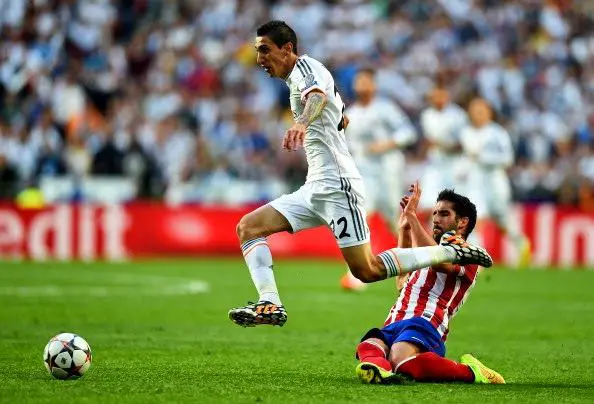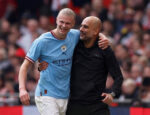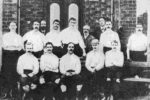 |
| Di Maria-Real’s best player in the champions league final,2014 |
Claude Makélélé is one of the most influential players in the history of modern football as he came to define the modern Holding Midfielder position. The growth of the Holding Midfielder position helped modern football tactics evolve from formations based around a two man central midfield, primarily a 4-4-2 formation, to formations built around a three man central midfield, primarily in 4-2-3-1/4-3-3 formations. Makélélé was not a physically imposing player and he did not cover a lot of territory. Most of his passes were short, and he rarely scored, but he was an invaluable member of his team. Makélélé’s greatest strengths were his positioning and awareness. His job was to sit at the base of his team’s central midfield and provide defensive cover for his team’s Centerbacks, allowing the other Midfielders and Attacking Fullbacks the freedom to attack. He and other Attacking Midfielders became the fulcrum of their teams. They provided the support to balance out teams built around a collection of attacking players.
Makélélé was bought by Real Madrid in 2000 at the beginning of the Galácticos transfer policy that was implemented by their new Club President, Florintino Pérez. Pérez’s ultimate goal was to fill his roster with a collection of attacking players who were commercially valuable world class players. Makélélé was never considered a Galáctico, as his game was not flashy and he relied more on intelligence and intangibles to influence matches. Makélélé played at the base of Real Madrid’s central midfield, providing protection for Real Madrid’s Centerbacks. This allowed Real Madrid’s collection of star Attacking and Central midfielders – Raúl, Guti, Steve McManaman, Zinedine Zidane and Luis Figo – the freedom to focus on attacking. Real Madrid also utilized a pair of Attacking Fullbacks in Roberto Carlos and Michel Solgado. Both were very attack minded Fullbacks who were responsible for providing the width for Real Madrid’s attack. This width was vital as their advanced runs allowed Real Madrid’s Outside Wingers the freedom to cut centrally allowing them to link play and become scoring threats. The deep positioning of Makélélé and the extra defensive cover he provided allowed both of Real Madrid’s Fullbacks the freedom to attack knowing that Real Madrid’s Centerbacks would not be left isolated and exposed by their attacking runs. The functional play of Makélélé provided support for Real Madrid’s more creative players to have the freedom to express themselves. By giving them this freedom Makélélé made each player more dangerous, individually, and made Real Madrid a more cohesive and stable unit.
Makélélé played for Real Madrid, from 2000-2003. During that time, Real Madrid won two La Liga titles in 2000-2001 and in 2002-2003, advanced to the Copa Del Rayfinal in the 2001-2002 season, and won the Champions League in the 2001-2002 season.Before the start of the 2003-2004 season Makélélé asked Real Madrid’s board for a raise on his salary; his request was subsequently refused by the board. To add insult to injury, Pérez made it publicly known that he did not rate Makélélé as a great player. Makélélé responded by handing in a transfer request and he was sold to Chelsea Football Club.
During the next three seasons, the last three seasons of Florintino Pérez’s first presidency, Real Madrid had disappointing results. They did not win a La Liga title and the closest they got was two second place finishes. Real Madrid advanced to one Copa Del Ray Final. They also struggled in the Champions League, progressing to the Quarterfinals only once.
Real Madrid lost their functional base when Makélélé was sold. Without the combination of functional and creative players, Real Madrid became unbalanced. There was no functional base to provide support for their skill players. Real Madrid’s skill players were not allowed the freedom to create without exposing their defense. Real Madrid lost the balance that teams must maintain in order to work as a cohesive unit and achieve success on the field.In the transfer window of 2011, José Mourinho signed Angel Di Maria to Real Madrid. Mourinho primarily positioned Di Maria as the Right Winger in Real Madrid’s preferred 4-2-3-1 formation. Di Maria fit perfectly into Mourinho’s Real Madrid as Di Maria’s greatest attributes, his high energy and athleticism, allowed him to flourish in a side that was built around limiting scoring chances for their opposition and aggressively attacking in transition. The disciplined style of Di Maria’s play helped balance out a side built around the attacking play of their Left Winger, the club talisman, Cristiano Ronaldo.
Ronaldo was signed in 2009 from Manchester United and is the face of Real Madrid Football Club. Real Madrid’s tactics are built specifically to maximize the goal scoring opportunities for Ronaldo and he is given the freedom to primarily concern himself with scoring goals. This attacking mentality regularly leaves Real Madrid exposed and is the biggest flaw that Real Madrid’s opposition uses to exploit and ultimately defeat Real Madrid. In an attempt to position himself in the most advantageous place to lead Real Madrid attacks, Ronaldo regularly stays high up the field, while not tracking back to mark opposition fullbacks’ attacking runs. This regularly leaves Real Madrid exposed down their left defensive flank. Thus, the addition of Angel Di Maria was vital to Real Madrid. With his defensive work rate and energetic play, he was able to provide the defensive support to solidify Real Madrid’s right defensive flank, allowing Real Madrid to focus on providing extra defensive support in the left flank.
What made Di Maria even more valuable was, while taking care of his defensive responsibilities, he was also effective in attack. In the 2010-2011 season he played in 51 matches, started in 42 matches, and scored 9 goals with 14 assists. In the 2011-2012 season he played in 32 matches, started in 23 matches and scored 7 goals with 16 assists. In the 2012-2013 season he played in 44 matches, started in 28 matches and scored 11 goals with 11 assists.At the beginning of the 2013-2014 season Real Madrid went through changes which unsettled Di Maria’s place at the club. By the end of the season, Di Maria and his style of play were more valuable than ever to Real Madrid. After failing to win the Champions League, Jose Mourinho, the manager that bought and valued Di Maria, was fired. In the summer transfer window, Real Madrid bought Right Winger Gareth Bale from Tottenham Hotspur for 94 million Euros. Bale was gifted the starting position on the Right Wing because of his transfer value and because the Club President, Florintino Pérez, has an infatuation with highly marketable, big name players. Bale’s addition meant Di Maria lost his natural starting position and his place at the club was in question, as he was a player that was bought and valued by Mourinho, but not a favorite of Pérez.
On November 16, 2013, Sami Kheidra, one of Real Madrid’s starting Central Midfielders tore his ACL and was unable to play the rest of the season until the last round of the La Ligaseason and the Champions League Final. This left Real Madrid’s new manager, Carlo Ancelotti, with a serious dilemma. Two of Real Madrid’s three central midfield positions were occupied by low energy creative players, Luka Modric and Xabi Alonso. Ancelotti had to find an energetic and physical Midfielder to balance out Real Madrid’s central midfield or they would be physically overpowered by their opposition. Ancelotti’s solution was to play Di Maria at the Left Central Midfield position. From this new position, Di Maria reprised the role he played at Benfica and he became more important than he ever had been in his Real Madrid career.
At Benfica, Di Maria’s previous club, he played the Wide Left Central Midfield position in a 4-3-1-2 formation. He played a multi-functional role helping to cover the tactical flaws of the 4-3-1-2 formation. The 4-3-1-2 is a formation that is designed to overload the center of the field by playing four Center Midfielders and two Center Forwards. However, by focusing on controlling the center of the field, teams who play a 4-3-1-2 can be exploited down both flanks as they only play one player, a Fullback, on each side. In defense, an overlapping Fullback who combines with a Winger can overload this single player. In attack, the lack of width allows opposing teams to play a narrow defensive formation and because there is less of a threat from wide areas, it makes it harder for them to be broken down.
The high energy level and movement of Di Maria helped solve the tactical weaknesses of the 4-3-1-2 formation. In defense he had a dual purpose. Primarily, he was responsible for playing in center midfield and making it difficult for Benfica’s opposition to play through them. Secondly, whenever the opposition’s Right Fullback made a free attacking run, Di Maria would leave center midfield to defend the opposition’s Right Fullback, negating the lack of defensive cover for Benfica’s Left Fullback in a 4-3-1-2 formation. In attack, instead of playing centrally and looking to link play, Di Maria made wide diagonal runs from center midfield down the left touchline. This movement not only provided the width that a natural 4 3 1 2 formation doesn’t have (which created more room for Benfica’s opposition to defend), but also put him in prime position to provide crosses for Benfica’s front two Center Forwards. With his high energy level and tactical discipline Di Maria was able to neutralize the major flaws of the 4-3-1-2 formation; he was able to do the same thing at Real Madrid in the 2013-2014 season.
In the Left Central Midfield position in Real Madrid’s 4-3-3 formation, Di Maria was again essential in negating the main tactical flaws of Real Madrid. In defense, he was able to provide the energy and physicality to provide the defensive cover for Modric and Xabi Alonso so Real Madrid was not overrun in central midfield. When Ronaldo chose not to track back and mark the opposition’s Right Fullback, Di Maria left his midfield position and marked the attacking Fullback, thus negating Real Madrid’s two main defensive weaknesses. In attack, from a central position, he made wide diagonal runs from central midfield down the left touchline. These attacking runs were valuable for two reasons. First, the extra width from Di Maria’s runs forced opposition defenses to expand creating more space for Ronaldo and Real Madrid to attack centrally. Secondly, Real Madrid now had a natural crosser down the left flank. With Ronaldo playing centrally partnering Real Madrid’s Center Forward, Karim Benzema, they had a two versus two advantage against their oppositions’ Centerbacks because the defending team had no defensive cover. During the 2013-2014 season Di Maria played in 52 matches, started 43 matches, scored 11 goals and had 22 assists. Di Maria capped his season off by having one of his best match performances for Real Madrid. In the Champions League Final he was by far Real Madrid’s most dangerous attacking player. The addition of Angel Di Maria to Real Madrid’s central midfield, and his energetic and technical play, balanced their defense and attack, bringing stability and cohesion to Real Madrid’s play. His energy in midfield and out wide helped protect Real Madrid’s other central midfielders, who were primarily responsible with creating scoring chances for Ronaldo and Bale. Also, he helped cover the defensive flaws of Ronaldo and created more space for Ronaldo to attack.
Just as when Florentino Pérez sold Makélélé before the 2003-2004 season, by selling Di Maria, Pérez has once again sold a player that provided the support to the creative players that gave them the freedom to express themselves. Both Makélélé and Di Maria were responsible for providing the balance to Real Madrid’s team that allowed them to play as a cohesive unit and at a high level. James Rodriguez is replacing Di Maria in the same role. Rodriguez, a flashier player who excelled at the 2014 World Cup and won the Golden Boot, does not possess the energy levels or discipline to replicate the success that Di Maria had in the unique Left Central Midfield position that he filled during the 2013-2014 Real Madrid season.
The last time Pérez made a decision like this – when he replaced Makélélé with David Beckham – Pérez was ultimately ousted as Club President. Another result of that decision was that Real Madrid did not win a trophy until the 2006-2007 season and even after spending hundreds of millions of Euros on new players, they were not a force in Europe again until the 2010-2011 season.
Because of the amount of money they spend on acquiring new players, Real Madrid will beat most of their competition. It seems they will attempt to use the 75 million Euro transfer fee to buy Center Forward Radamel Falcao. Even though they have struggled to break down organized defenses, Real Madrid will continue to beat small and medium sized clubs, as they have beaten Sevilla and Cordoba this season. However, Real Madrid will struggle against clubs who have the managers and players to fight with Real Madrid, as happened in their Supercopa de España loss to Atlético Madrid. These difficulties could very well cost Real Madrid both the La Liga and Champions League titles.
Nicholas Peters–@Nick_PPeters









Recent Comments